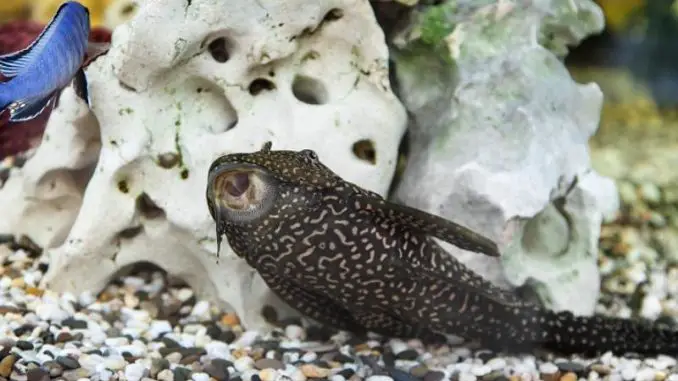
Sucker fish are a family of 80–100 freshwater fish that live in Northern American waters. These fish get their names from their suckermouths, which they use to graze on algae and cling onto objects, including the sides of fish tanks.
Sucker fish are characterized by their flat bodies and large mouths. These fish are popular among aquarists due to their unique appearance and their ability to keep the tank clean.
Watching sucker fish eat food and stick to surfaces with their mouths is guaranteed entertainment, and these fish also have laid-back personalities that make them good tank mates for most fish.
TABLE OF CONTENTS
Sucker Fish Facts & Overview
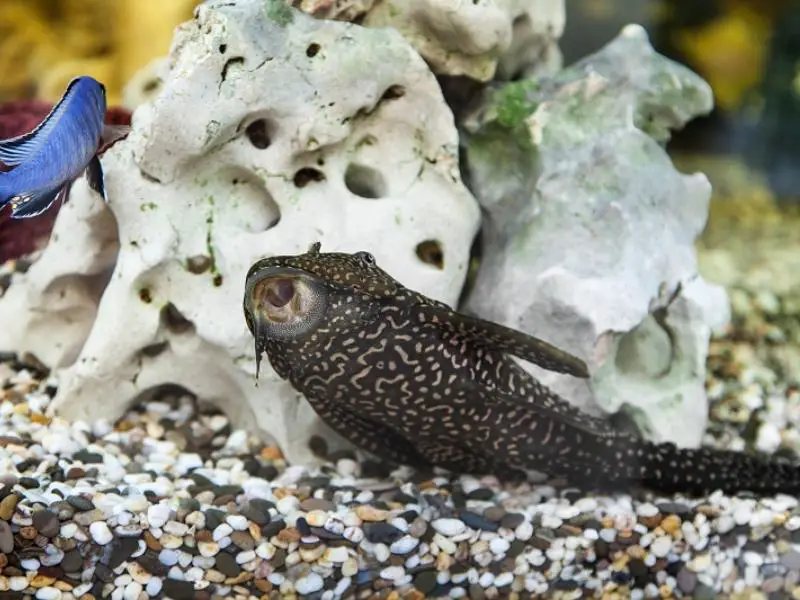
| Scientific name: | Hypostomus plecostomus |
| Common names | Sucker fish, common pleco, |
| Distribution: | South and Central America, Russia, China |
| Size: | ~12–24 inches |
| Life expectancy: | Up to 20 years |
| Color: | A variety of colors and patterns and sometimes with spots and strips |
| Diet: | Omnivore |
| Temperament: | Mild |
| Minimum tank size: | 20 gallons |
| Temperature: | 72–78°F (22–28°C) |
| pH: | 6.5–7.5 pH |
| Hardness: | 5–19 dGH |
| Care level: | Easy |
| Breeding: | Egg-layer |
Origin
The sucker fish is native to freshwater lakes and streams in South and Central America. The common pleco (Hypostomus plecostomus) is the most popular type of sucker fish.
Most commonly found in slower-moving channels of reservoirs and rivers, sucker fish are bottom feeders and spend most of their time exploring riverbeds. Outside of America, these fish can be found in Russia, and a single sucker fish species is also native to China.
Adult Size & Lifespan
Adult sucker fish reach up to 12 inches long, and some species of sucker fish grow up to 24 inches. In captivity, the maximum length for a sucker fish is usually 18 inches. Males are slimmer and more colorful than females, and have more pointed dorsal and anal fins than females.
The lifespan of a sucker fish in the wild is up to 20 years. In captivity, sucker fish live between 10–15 years.
Availability
Sucker fish are common in pet stores, where the fish are often categorized as algae eaters. Depending on the species of sucker fish you buy, the price ranges from $5 to $50 per fish.
Appearance & Behavior
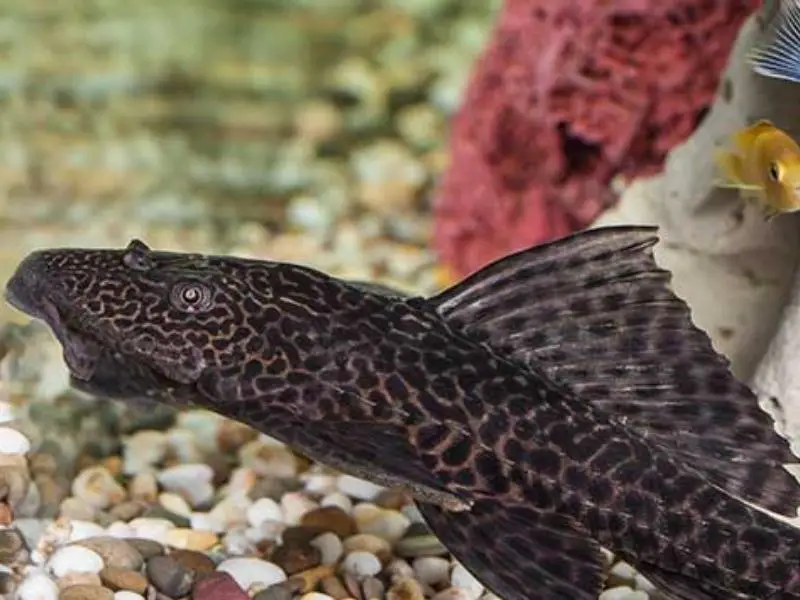
Sucker fish are well-known for their O-shaped mouths and thick lips, which help the fish nibble algae and cling onto the bottoms of streams.
You can find sucker fish in a range of colors, including black, yellow, green, white, blue, orange, white, and gray.
Although sucker fish are closely related to minnows, sucker fish have spineless anal fins that are much further back than their dorsal fins compared to minnows.
Sucker fish have forked tails and are scaleless on their opercles and cheeks.
Female sucker fish are plump, with thick bodies and male sucker fish are more colorful than female fish.
Stressed sucker fish change color and develop a lighter or darker coloration. During breeding season, female sucker fish swell, appearing rounder than usual.
The most common type of sucker fish is the common pleco, which has expansive fins, a flat belly, and an upturned mouth.
Other subspecies of sucker fish are similar at first glance but have different sizes, patterns, and colors than common plecos.
Typical Behavior
Sucker fish are non-aggressive and can live together with other peaceful fish in an aquarium. They get on well with other species of tropical freshwater fish. With that said, an overcrowded tank can cause a sucker fish to become aggressive.
To ensure your sucker fish thrives in their tank environment, make sure the tank is big enough for all of the tank mates. Don’t add any other burrowing fish to the tank.
Sucker fish have been known to fight other fish, in particular eels and knife fish, so these fish wouldn’t be good tankmates.
Sucker fish are slow swimmers and spend most of their time at the bottom of the tank, where they burrow in the substrate and nibble on algae. However, sucker fish often jump out of the water, so you should invest in a tank with a lid.
As nocturnal fish, sucker fish don’t like bright lights and are more active at night. Dim your tank’s lights if you want to see your sucker fish swimming around in the day.
Most sucker fish spend the day hiding in a cave or a crevice. With that said, some fish adapt to aquarium life and are more sociable than others.
Sucker fish scrounge for leftover food at the bottom of the tank. Your fish won’t become more active the moment you add food to the tank.
Make sure enough food falls to the bottom of the tank for your sucker fish to eat. Sinking pellets are a great way to make sure your sucker fish gets food in a well-populated tank.
Sucker Fish Care
Sucker fish are easy to care for thanks to their laid-back personalities and their willingness to eat leftovers.
Because sucker fish are tank cleaners, these fish reduce your cleaning duties and are a helpful addition to your aquarium.
The tank setup, including water type and decorations, should mimic the sucker fish’s natural habitat of slow-moving freshwater rivers and lakes.
Feeding a sucker fish is easy. These fish eat algae and leftover food that sinks to the bottom of the tank.
Disease
Sucker fish are hardy fish, but they’re still susceptible to some common aquarium diseases. The diseases that most often affect sucker fish are listed below.
Ich
Ich, also called white spot or ick, is a common freshwater fish disease that is characterized by tiny white spots on the fish’s body and fins and is caused by poor tank conditions.
To treat ich, buy over-the-counter medications and raise the temperature of the aquarium by a couple of degrees to speed up the life cycle of the protozoan.
Dropsy
Dropsy is a bacterial disease that eats away at a fish’s organs. Scales that stick out slightly and a swollen abdomen are both symptoms of dropsy.
You can treat dropsy with antibiotics and kill bacteria in the tank by adding a teaspoon of aquarium salt for every 10 gallons of water.
Fin Rot
Fin rot causes loss of coloration, lethargy, loss of appetite, discolored fins, and bloating.
To treat fin rot, change 25% of the tank’s water every couple of days and make sure your fish is fed high-quality food. Medication can be used if symptoms don’t improve within a week.
Pop-Eye
Sucker fish with protruding eyes are likely suffering from pop-eye, a bacterial infection caused by poor food and water quality.
Treat pop-eye and hole in the head with antibiotic foods and tank solutions.
Hole-in-the-head
Hole-in-the-head is characterized by small holes in the fish’s head.
This disease has no known cause, although it’s theorized that poor water quality, a lack of nutritious food, and over-exposure to activated carbon are responsible.
Treat hole-in-the-head with medicated fish food.
Fish Fungus
White or grey spots on a sucker fish’s body indicate fungal growth, a common disease caused by mold. Fish fungus often occurs if a fish has scraped its skin, providing the ideal fungus breeding ground.
Treat fish fungus with a medication recommended by specialists at your local fish store.
Habitat and Tank Requirements
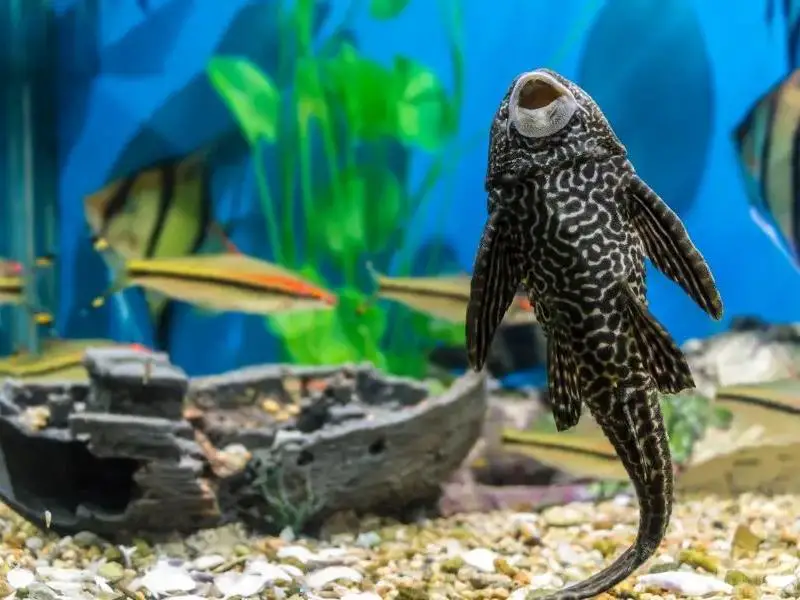
The natural habitat of a sucker fish is freshwater rivers and lakes. Sucker fish like to hang out in slow-moving channels, where they can suck up plants and small invertebrates.
The water type, temperature, and pH should all be adjusted to suit the sucker fish’s preferred environment. Tank decorations help to make a sucker fish feel at home in your aquarium.
Tank Conditions
The right tank conditions will help you raise a happy, healthy sucker fish. Most importantly, the water should be at the right temperature for your fish.
Sucker fish are used to warm waters of between 72 and 78°F. Using an aquarium heater is the easiest way to achieve this temperature, and you can check the temperature daily with a thermometer.
Water that is too cold or too hot could cause your fish to get sick or die.
Conveniently, sucker fish don’t need an exact water pH, but it’s best to keep pH between 6.5 and 7.5. These fish need a water hardness of between 5 and 19 dH.
A well-functioning filter is essential for a sucker fish tank, because they produce a lot of waste.
The average 50-gallon tank requires a filter that can handle 200–250 gallons of water per hour, allowing for 4–5 tank filtrations every hour.
Regular cleaning and water changes will maintain optimal water quality and prevent the sucker fish from getting sick.
At least 2.5 inches of substrate will give your sucker fish plenty of opportunities to hunt, dig, and slide along the bottom of the tank.
Aquarium sand is most appropriate for sucker fish. Don’t use aquarium gravel unless the gravel is soft and won’t scratch the fish’s delicate underside.
Because sucker fish enjoy uprooting and eating plants, only deep-rooted and quick-growing plants are suitable for these fish.
Find leafy plants that sucker fish can hide beneath, like Amazon sword and java fern. Decorations like caves and large pieces of hollow driftwood provide a place for sucker fish to relax.
Tank Mates
Sucker fish have calm temperaments and enjoy the company of other fish.
You can house sucker fish with any other fish species, with a few exceptions.
It’s best to introduce tank mates that dwell in the top and mid-sections of the tank because these fish won’t disturb your sucker fish.
To prevent territorial issues, don’t house sucker fish with other burrowing fish, like eels and burrowing loaches.
Crabs and snails make bad tank mates for sucker fish because crabs will nip the fish, and snails will likely get eaten.
Sucker fish also shouldn’t be housed with aggressive fish that need to be housed alone, like betta fish.
Some of the best tank mates for sucker fish are:
- Hatchetfish — Because hatchetfish spend most of the time in the upper waters of a tank, they rarely come across their sucker fish tank mates. Hatchetfish are peaceful schooling fish, and do well in most community tanks.
- Pencilfish — Like sucker fish, pencilfish thrive in tropical water temperatures and are easy to care for. Pencilfish are smaller than sucker fish and are attractive in any tank setup.
- Oscar fish — Oscar fish are top-dwelling fish that enjoy sharing an aquarium with other inhabitants. Because oscar fish can grow up to 12 inches long, you’ll need a bigger tank if you decide to house oscar fish with sucker fish. With the right tank conditions, oscar fish and sucker fish will live peacefully together.
- Tiger barbs — Tiger barbs are showy fish that dominate the middle of the tank. These fish are a peaceful, schooling species and only occasionally chase long-finned fish. Like sucker fish, tiger barbs have long lifespans.
- Hoplo catfish — Hoplo Catfish swim in all levels of the water column. Mild-tempered and tolerant of a variety of water conditions, hoplo catfish enjoy lurking at the bottom of the tank, but these fish will calmly swim away if pursued by sucker fish.
Sucker fish are peaceful fish, but an overcrowded tank can stress out a sucker fish and cause the fish to bully its tank mates. Give sucker fish plenty of space to prevent this from happening.
Diet and Feeding
In the wild, sucker fish eat insects and small fish, but algae and plant matter is the fish’s main food source. You should provide the same, largely herbivorous diet to sucker fish in captivity.
In an aquarium, sucker fish scour the tank for algae, but most tanks won’t contain enough algae to provide a sucker fish with its daily food.
Feed sucker fish twice a day, removing any leftover food every morning. Algae wafers, lettuce, broccoli, cucumber, and melon are good foods that sink to the bottom of the tank for sucker fish to eat. Add a pinch of food to the tank, and cut back on future feeding if there are any leftovers.
Breeding
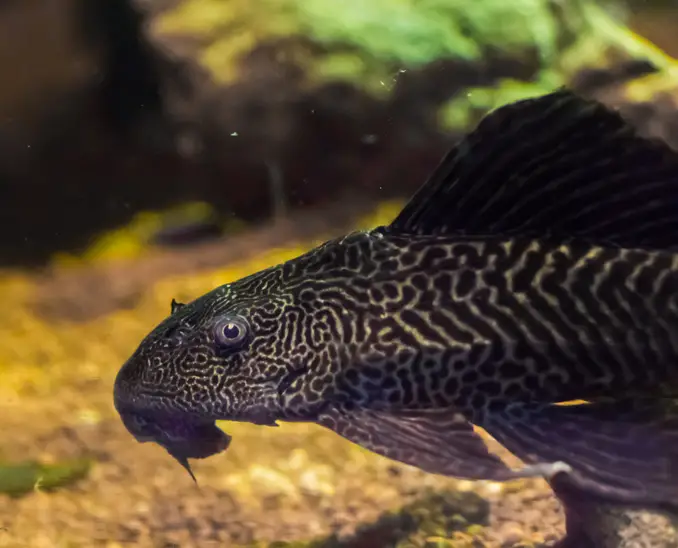
Breeding sucker fish takes effort, but sucker fish are easier to breed than other freshwater fish. The same basic techniques apply when breeding all types of sucker fish.
Here’s what you should do:
- Place a male and female sucker fish in your tank.
- Choose a location in the tank for spawning and place driftwood, a small flower pot on its side, or an old coffee can in the chosen area. These items are suitable breeding grounds for sucker fish.
- Drop the temperature in the aquarium to 65°F and complete a 75% water change to mimic the fall season, when sucker fish usually spawn.
- Allow several days for spawning to occur, and look for eggs in the breeding area every day. The male should be protective of the eggs’ location if spawning was successful.
- After 10 days, the eggs should hatch. Drop vegetables like peas, romaine lettuce, and green beans into the tank for the maturing fish and adult fish to feed on.
- Prepare a temporary tank and transfer the maturing fish into this tank. This will prevent the sucker fish parents from eating their fry.
Should You Get a Sucker Fish for Your Aquarium?
You should get a sucker fish for your tank if you can provide enough space for a bottom-dwelling fish with peaceful tank mates. Make sure you have the right substrate and tank decorations to prevent injuring the fish and make your sucker fish feel comfortable.
You shouldn’t get a sucker fish if you already house other burrowing fish or aggressive fish in your tank or if you’re using your tank to breed snails.
Sucker fish are hardy, low-hassle fish that provide an excellent source of entertainment in a community tank setup. Not only are sucker fish easy to look after, but these fish also help to keep the aquarium clean with their algae-eating habits.
With their diverse color and pattern variations, sucker fish are a guaranteed colorful addition to any home aquarium.



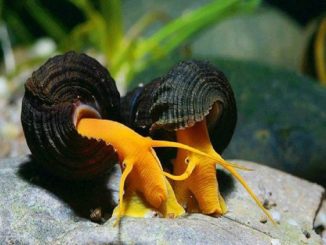
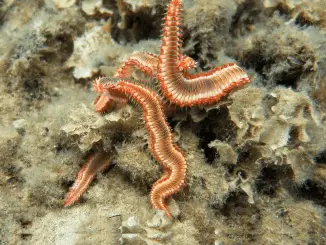
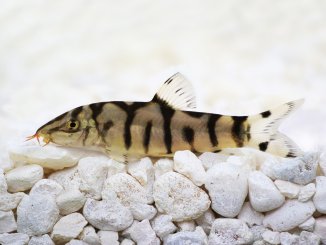
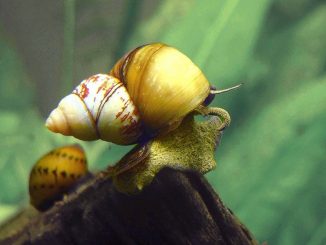
Be the first to comment